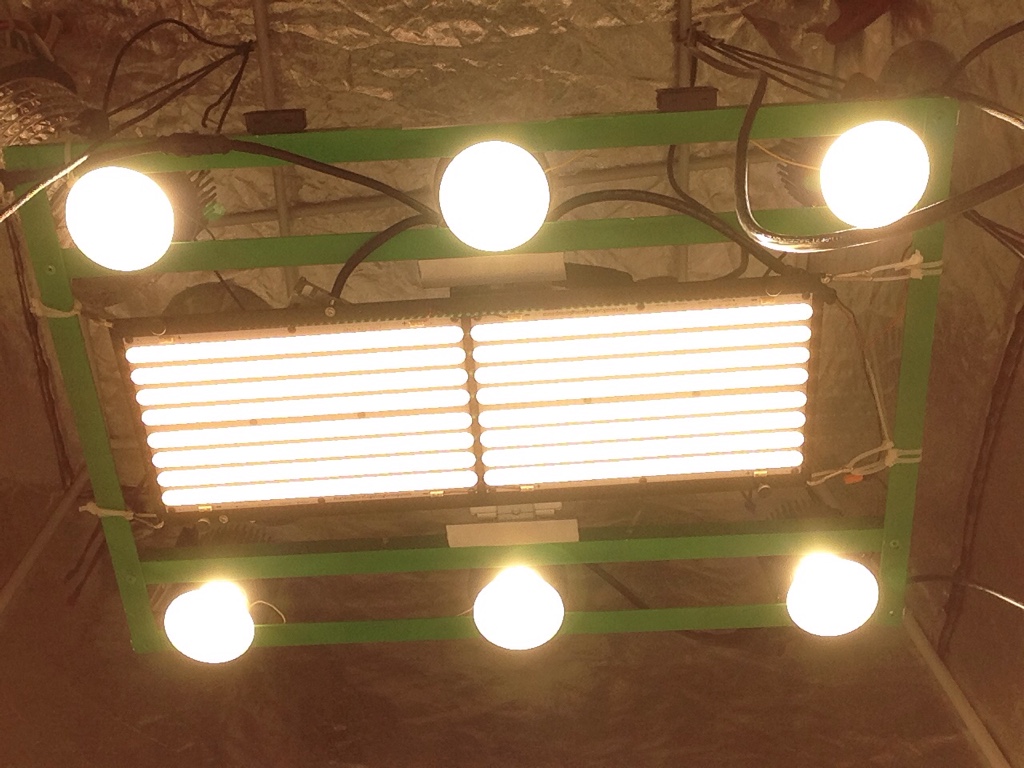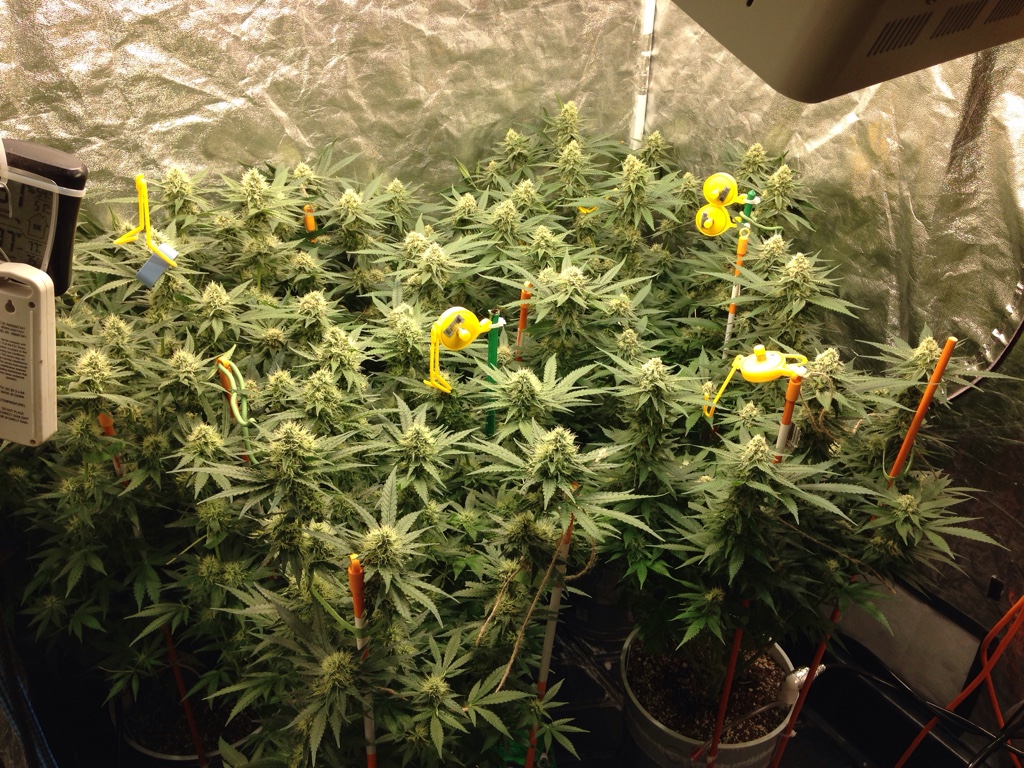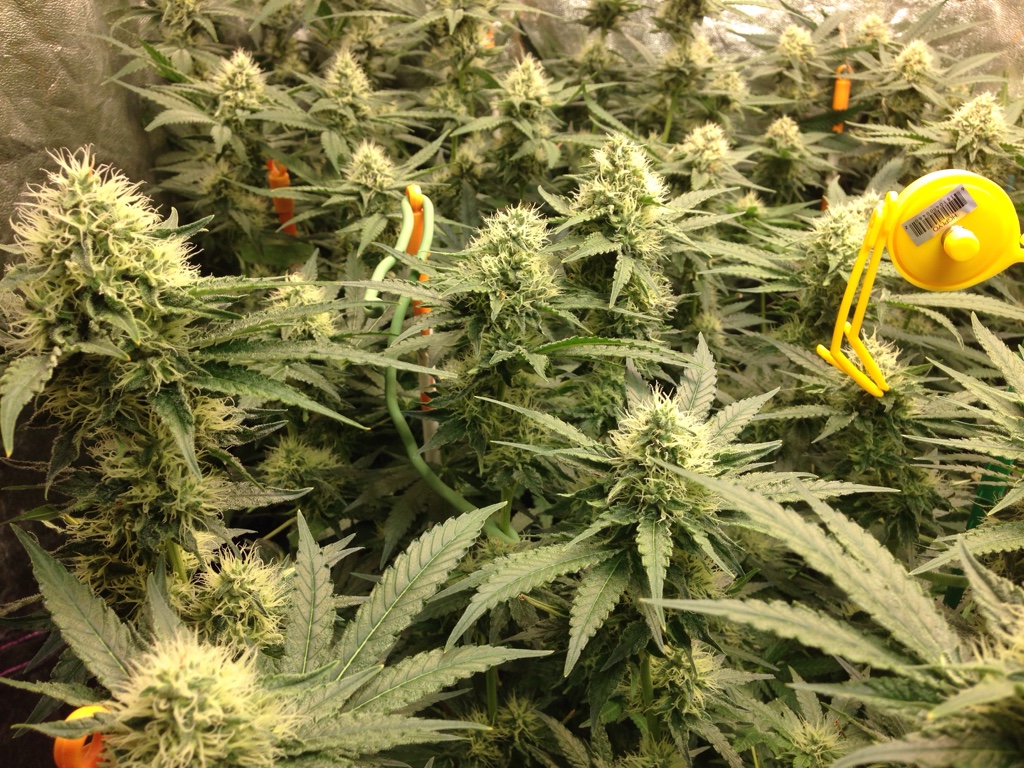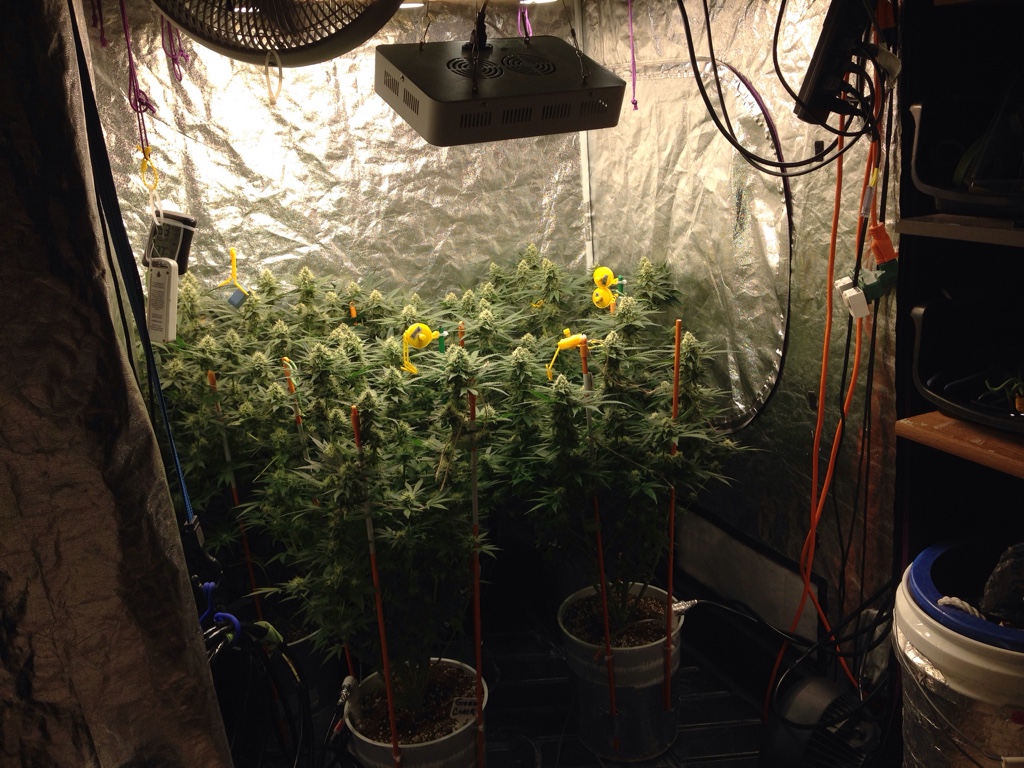Skullman420
Well-Known Member
Thank you for that writeup. Wery well explained. May copy your explanation next time I get that questionPAR is the way to go for the most accurate method of choosing plant lighting.... Here is a writeup I did explaining everything you need to know about PAR.
Understanding Light
Let's say we are looking at the sun, we can see visible light, but there is also a lot of other types of energy or rays we commonly call them released as well. We all feel the sun on our bare skin warming up and this is mainly due to visible light and Infrared light. Or we have all gone to the beach or a pool and put on sunscreen to block the UV rays that can harm our skin and cause cancers. We know that putting food in the microwave can also warm it up and we know that gamma waves from nuclear waste are very very harmful to anything living. We even go and get X-Rays to look inside our bodies in search of broken bones.
These Rays that we refer to are groupings of Electromagnetic Radiation (EMR) and are measured and ordered by their "wavelength", in the units of nanometers. EMR is released in Photons, which show characteristics of a wave and a particle at the same time. If we were to look at a photon, it would have properties like an ocean wave, with peaks and valleys. We measure the "wavelength" of EMR by measuring the distance between the crests(peaks). For EMR, this is measured in the unit Nanometers most of the time when relating it to visible light, and the longer the wavelength, the less energy the photon has, where as the shorter the wavelength, the more energy it has.
Now these groupings "rays" we were referring to above are ordered by wavelength in this order:
In order from High energy to low energy here is the order:
Gamma rays, X-rays, Ultra Violet, Visible Light, Infared, Microwaves, Radio Waves.
Now by knowing this, notice how all High energy, short wavelength light is harmful to things like humans and plants (UV, X-Rays, Gamma Rays). The reason for this is that they contain so much energy that it can damage living tissues. On the opposite end of this, notice how all long wavelengths like radio waves, Microwaves, Infrared and Visible light are virtually harmless to living things, this is because they contain low energy.
Now that you understand this, let's explore PAR:
What is PAR?
PAR or Photosynthetic Active Radiation is the range of wavelengths that drive and influence photosynthesis. Just like we have the groupings of X-Rays and Microwaves, PAR is a grouping of EMR that specifically drives plants photosynthesis. This grouping or range is measured between the 400nm wavelength (deep purple) and going to 700nm wavelength (Far-red) generally, but some scientists argue that it actually can extend from 380nm(UV-A) to 780nm (Infrared). Generally most light manufactures in the horticulture world and even most research I've read deals with 400nm-700nm range when referring to PAR.
Here are the general wavelengths and the visual names we represent them by.
UV Light
UV-C: 100—280nm, (Very harmful to skin, eyes, microbes and bacteria)
UV-B: 280—315nm,
UV-A: 315—400nm
Visible Light:
Violet: 380—450 nm
Blue: 450—495 nm
Green: 495—570 nm
Yellow: 570—590 nm
Orange: 590—620 nm
Red: 620—750 nm
Infrared: 700nm-1mm (1 millimeter)
So even though PAR light is pretty much the same as the light we see referred to as visible light, the abbreviation PAR is used because it specifically deals with the range of light that drives photosynthesis.
(in this photo, the blue range is the PAR range)
So why is PAR important to measure for plants?
By now you probably have heard the terms Lumens, Lux, PAR, footcandles, candlepower. Well what is up with all these measurements, why are some important, some not. You probably have also heard the term "Lumens are for humans, PAR is for Plants" Well why is PAR so much more important than these other measurements when dealing with plant lights?
This is an easy question to ask, but much much harder to explain. I will do my best.
Since PAR is the range of light that drives photosynthesis, we know as wavelengths from 400nm-700nm (violet to red), when EMR or Light is emitted in this range in comes in little packets called photons. When these photons fall upon a plant leaf, some are reflected, and some are absorbed. Now when we look at photosynthesis in general, when approximately 8-12 photons are absorbed into a leaf, this will split up one molecule of CO2 (photosynthesis). Once absorbed, these photons releases electrons which then go through a complex process and eventually split this single CO2 molecule apart. So now that you know this, you can see how the amount of photons a plant absorbs, will directly effect the rate of photosynthesis.
Now like I mentioned, once a photon is absorbed, the wavelength/color doesn't matter much. Importantly noted though, before a photon is absorbed, when it first hits the leafs surface, it can be reflected. Now commonly you may have heard this is the reason that plants are green, because they don't absorb green light, they reflect it, but this is only partly true. Plants actually do absorb green light, just not as easily as other colors like red and blue. So those that say "plants don't absorb green light" typically believe they don't absorb any green light and this is false, and actually the graph below will show the wavelengths of light that plants reflect, and the amounts. You will see that all light in the PAR range is absorbed, and the difference between blue which is absorbed nearly at 100% vs Green absorbed around 80%, there is only a difference of about 20%. The common believe that plants don't absorb green light is why the LED market originated by offering lights with only 2 bands, red and blue, however as more research came into play it was realized that all wavelengths of light are absorbed which is why you see many full spectrum panels on the market now.
So now that you understand how Photons directly drive photosynthesis (in general terms), you can understand why measuring PAR is important...Plants are pretty much photon counters, the more photons available, the more photosynthesis occurs.
What is a PAR measurement, and why is it useful?
A PAR measurement, known in the lighting world as PPFD or PPF
PPFD is Photosynthetic Photon Flux Density, and this measurement describes how many photons, fall on a square meter, every single second. PPFD is a useful measurement when determining how high to hang a light, how far will a light actually cover, and what size light you need for a certain type of plant and grow area. This is a directional measurement in which readings are generally taken on a surface that would represent the canopy of your plants.
PPF is Photosynthetic Photon Flux, and this measurement is used mainly to compare lights for their Photon efficiency. What I mean by this is PPF is a omnidirectional measurement and irregardless of direction, it measures all TOTAL photons emitted from a light. PPF is usually measured in an integrating sphere or Ulbricht Sphere which is a huge reflective sphere that measures light coming from a source at all angles and directions. This measurement is usually used more for HID bulbs than LED but can be used for both when comparing how efficiently a light source creates photons per watt, many times measured in the units Mols/Joule. Other than comparing light sources for photon efficiency, this measurement of PAR light isn't used much. PPF is much more usefull for comparing HID bulbs, so you can see at a same wattage and same ballast, which bulb will product more photons in the PAR range vs another. Being that the bulb would go into a reflector and shape the output, PPF is used to compare the actual bulb's photon efficiency, but also could be used to compare one LED panel to another at a Same wattage. It wouldn't show you anything about coverage, or hanging height, just which panel at the same wattage produces more photosynthetic active photons.
When we are looking at picking the right grow light we are typically using PPFD. We want to know on a flat surface (our canopy) how many photons are falling here every second. As we described above, plants are photon counters, and so the more photons that are falling on a surface, the higher the rate of photosynthesis. This is why its very important for grow light manufactures to list PAR data, usually in the form of a 4'x4' grid, where at each 6" or 1' mark a PPFD reading is taken. This lets us know when a light is hung at "X" distance, then we can expect "Y" amount of PPFD to be available for the plants.
Now to measure PAR, you probably have seen in my video by now the Apogee Quantum Meter I am using. This device uses separate photodiodes to sense photons and basically counts them. As plants are photon counters, my quantum meter also counts photons, and this reading is displayed in the units Micromoles/Meter squared/every second, and usually written like this " 500umol/m2/s-1.
I do want to notate that the PAR meter I am using is fairly accurate, but there are much better ways to measure par. There is a Li-Cor brand PAR meter which is much more accurate than the Apogee one I have because it is more sensitive to blue/red light than the one I use, however for reference and general purpose testing this pricey $360 Apogee fit my needs and my budget. The Li-Cor is up over $1000. The most accurate way to test for PAR is using a Spectroradiometer, but those cost $3500 on the low and and can go as high as $20,000 or more for lab grade ones. The reason that Spectroradimeters are more effective is that they break white light into tiny little bands just a few nanometers in range, and have individual sensors for each little band, where most quantum meters use photoelectric diodes and usually have 3 or 4, so their sensitivity is less than a spectroradiometer would be.
Apogee MQ200 error range... notice on the chart the boxed in area is the PAR range and an ideal PAR meter would be equal across this range in sensitivity, therefore you will see in the deep red and deep blue it is less accurate.
Here is the Li-Cor quantum meter error range and response chart. Notice it is slightly more accurate but still not perfect.
OK, so you now showed me your photon counter is 500umol/m2/s-1, but what does this mean to me?
So we have these PAR measurements, now what do they mean when talking about plants. The best way to look at this is that a plant has a certain "requirement" of the amount of photons it needs during the daylight period of growth. Each plant species has its own light requirements and you may even remember mom talking about this gardening when you were little, planting tomatoes in a sunny area of the yard where other houseplants didn't need as much light and would do fine in a windowsill. In bottany related applications this "light requirement is known as Daily Light Integral or DLI.
What is DLI
DLI is the amount of photons a plant need per day to be in optimal light for growth and photosynthesis rates and as I mentioned above each plant species is different. DLI is typically measured in Mols per meter squared, per day (very similar to PPFD) but instead of each second, this measurement is totaling all photons per daylight period.
A low light plant such as a fern only needs 6-10 mols/m2/day of photons to grow which is why ferns are commonly seen in dense forests under the canopy.
A high light plant such as Cannabis needs a minimum of 22 mols/m2/day of photons to as high as 65 mols/m2/day which is the range of optimal growth. Yes if you don't have that much light, cannabis will still grow, but you will typically see lower yields, less dense buds, lower THC percentages because the plant isn't operating at its best.
Converting DLI to PPFD
Now how do we get from DLI Mol/m2/day to PPFD or micromoles/m2/second.
The formula to convert this would be:
You would use this formula...
PPFD x 0.0864 = DLI
OR
DLI / 0.0864 = PPFD
So lets look at cannabis, knowing that cannabis needs at least (Minimum for optimal growth) 22mol/m2/day DLI at minimum for optimal photosynthesis lets break it down.
22 / 0.0864 = 254.6 micromoles/m2/s-1 (PPFD)
This is the amount of photons you need every second, averaged over 1 square meter, for the whole 24 hours if usuing a 24/0 daylight schedule (no dark period).
So what happens if you are using a 18/6 veg period or a 12/12 flowering light schedule... simple...
If using a 12/12 flowering schedule, you are only using 12 hours of the 24 hours of the day, which means you would take the 254.6 Micromoles/m2/s-1 and multiply it by 2, since you are reducing the amount of daylight by 1/2 (12 hours), then each hour of the daylight period you need double the amount of photons... so in this example you would need 509.25 micromoles/m2/second.
If using a 18/6 schedule, you are using 3/4 of the amount of daylight with 18 hours on, 6 hours off, therefore you would multiply the 24hr PPFD by 1.5 because you are using only 3/4 of the day, or 1 1/2 times the 12 hour requirement. In this example a DLI of 22, under a 18/6 schedule would amount to 381.5 micromoles/m2/second.
So for cannabis, bottom threshold for optimal growth and photosynthesis is a DLI of DLI of 22 would be:
****Going lower than these numbers will still grow cannabis, however yields, bud density, potency and THC percentage may suffer.
24/0 schedule: 254.6 micromoles/m2/s-1
18/6 schedule: 381.5 micromoles/m2/s-1
12/12 schedule: 509.25 micromoles/m2/s-1
For Cannabis, the Top threshold for optimal growth and photosynthesis is a DLI of 65 moles per day.
***extremely important notice, only go up to these amounts if you are using supplemental CO2, do not go this high if you are not using supplemental CO2 as you will actually slow down photosynthesis and waste energy.
24/0 schedule: 752.31 micromoles/m2/s-1
18/6 schedule: 1128.465 micromoles/m2/s-1
12/12 schedule: 1504.6 micromoles/m2/s-1
The generally accepted guidelines for artificial light PPFD in flowering are this:
in a 12/12
PPFD of at least 510 micromoles/m2/s-1 for the low end of optimal intensity
PPFD of at least 800-1100 micromoles/m2/s-1 for perfect optimal lighting without additional CO2.
PPFD of at least 800-1500 micromoles/m2/s-1 for perfect optimal lighting WITH additional CO2.
So now that we know what all these numbers mean, how to we interpret these PAR charts or 4'x4' grids with PAR readings?
Typically if a Lighting company presents a PAR chart "4'x4' grid" with measurements, you will see a bunch of readings all over the place.
Even though PAR measurements are in micromoles/METER/second this is with a constant and even light source what the average would be... grow lights, especially LED's do not have an even footprint and intensity can change rapidly over just 6" or 1" away from the center of the light. This is why these 4'x4' PAR grids are important because the light source is not even, it shows us the Actual area that will produce the OPTIMAL amount of PHOTONS for driving photosynthesis at each point of the grid.
So now knowing for flowering you need to see a grid with a bunch of 510's all over it or higher for flowering, you can see exactly how far a light will spread to OPTIMALLY drive your plant. Also, usually when a company makes these grids, they do it at heights of 12", 18", 24" and 36". By comparing the charts, you can tell at what height a certain light will spread providing 510's or higher and at what height would be optimal to hang the light. The closer the light is to the canopy/or meter, the higher the amount of photons that will be hitting it, but the narrower the coverage area will be (less light is scattering). The further away you move the light, the more photons that scatter leaving less to hit the canopy resulting in a larger coverage area but less Photon Density (PPFD).
Now if you don't see 510's or higher across your chart for your light, does that mean it wont work...NO.. it will just produce less photosynthesis which typically results in more airy buds, less potency and THC, and lower yields.
You can also look at these charts to see how you would hang multiple lights, by combining 2 charts together... lets say 2' out from the center of your light, the chart is only reading 250 micromoles/m2/s-1, well you know if you added a 2nd light and combined their outputs, with them spaced apart 2 feet from each other, then that center point between them (the 250 micromole/m2/s-1 mark) would double, now making that area optimal for flowering in a 12/12 schedule.
This is why it is important that companies provide this information, so we can all make accurate decisions on plant lighting for our plant species, photoperiod usage, and making sure to have a even light footprint over our canopies.
So all and all the things you will want to remember from this are:
*Light plants use is in tiny packets called photons.
*Plants count photons, this count directly drives photosynthesis.
*Only photons with a wavelength of 400nm-700nm matter for photosynthesis (some say 380nm-780nm)
*All colors of Light/wavelengths in the PAR range will absorb, at 80% or higher rates
*PAR measurements are taken with a quantum meter or spectroradiometer and are measured in micromoles per meter squared per second (umol/m2/s-1)
*When choosing a lights by PAR measurements we are looking for a PPFD of 510 umol/m2/s-1 or more across the entire canopy for optimal flowering results, less will still work but not at optimal levels for best results
*Having a 4'x4' grid with PAR measurements at different heights is the best way to judge a plants actual optimal footprint/coverage area based on plant type and photoperiod. Also aids with hanging height and blending of multiple panels/lights.
I hope this gets you on PAR with PAR, I tried to explain this complexity in the most simplified manner possible. If you have questions, ask, I will be happy to answer them.









